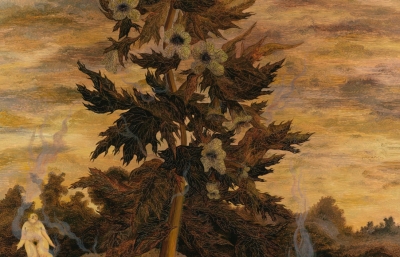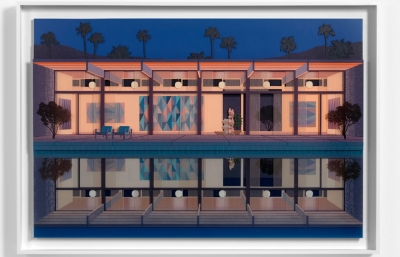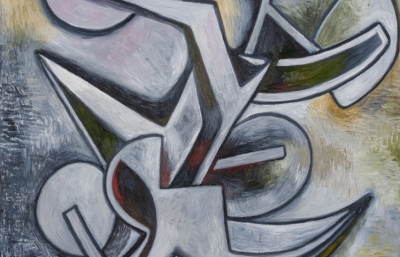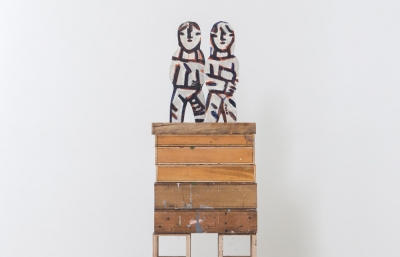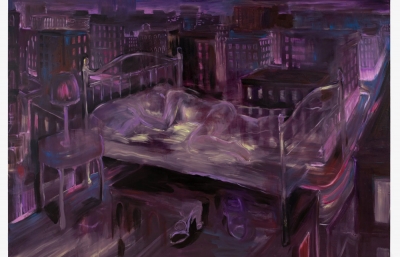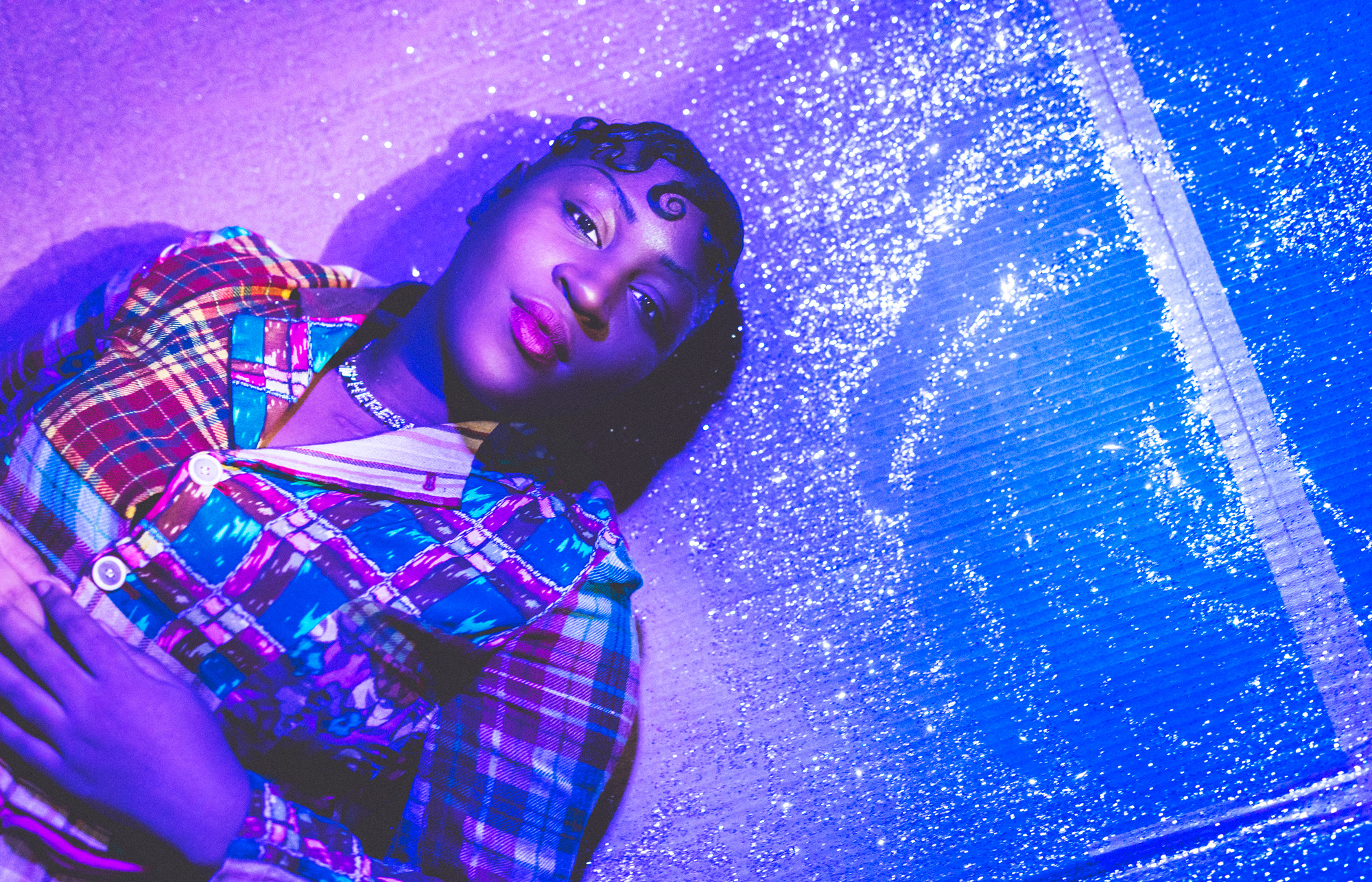
Theresa Chromati
Grace in Her Space
Interview by Kristin Farr // Portrait by Bryan Derballa
A silver lining, a rainbow, or a sprout pushing through pavement—there are countless ways to analogize the subversion of negativity, but togetherness is key for positive transformation. Theresa Chromati’s paintings celebrate the unparalleled power of community among black women, and her work inspires a hard examination of expectations as her figures are set free to dance, be natural, and own the space they have always deserved. She is quite literally turning scars into sparkles.
Chromati is a Brooklyn artist who has already lived other lives as a designer and clarinetist, and she’s now a multi-sensory storyteller, making mixed-media work that moves, shakes, and expresses the depth of female bonds, among other personal and universal tales.
Kristin Farr: What are all the mediums you work in?
Theresa Chromati: Mainly painting and collage, primarily acrylic paint. I use glitter, vinyl plastics, silk fabric, and I have also played with cotton and bandanas. I’m really interested in adding textures and different elements. I’ve worked digitally, and I’m working with wood now, and I’m trying to move in the direction where the surface plays into the context of the work.
I’m working on a series about events that happen through the eyes of people who are stoop sitting, spending a long time sitting on the steps, including certain events that happen on the street. It captures people on these steps doing nostalgic things from my childhood, like eating sunflower seeds. Another painting is called Stoop Rapunzel, and it captures a young woman walking down the steps, her hand being held by a boy, and the mother’s looking out the door—little moments like that. The wood I painted on was shaped like a house.
I remember eating sunflower seeds. They’re a lot of work.
They are. It was just something you did, even if you didn’t really like them. My mom never bought sunflower seeds, but the kids in my neighborhood loved them, so I just ate them because it was like a way of belonging.
The gateway to smoking.
Right, it’s the same structure. We’re clearly from two different places, but you still have the same memory of something that most people would never talk about unless it came up, so I’m trying to consider those things and put them into the work.
We should talk about glitter.
I just have a natural attraction to glitter. A lot of what I’m trying to say in my work is about the beauty and confidence of black women, and depicting moments of partnership among them.
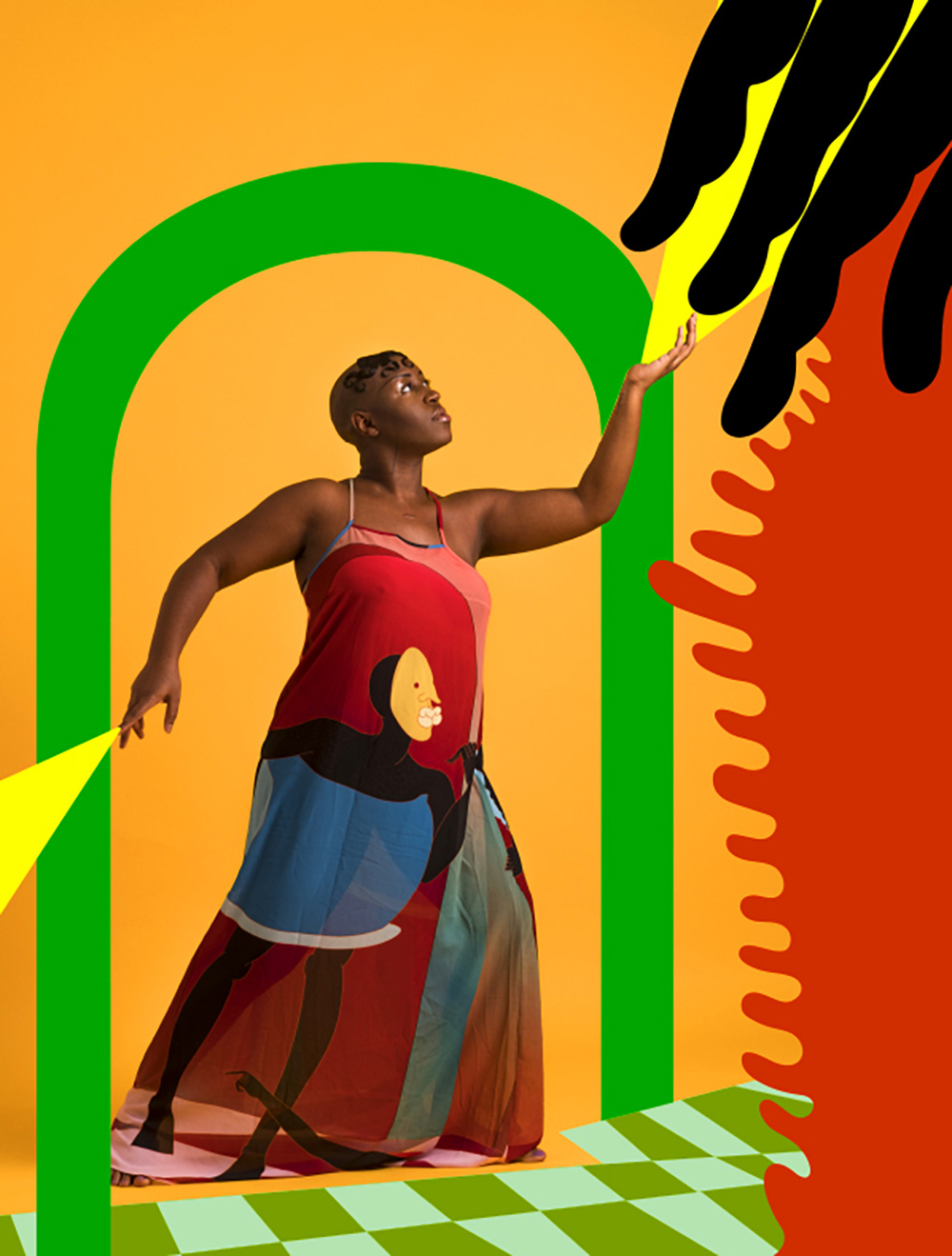
There’s also proximity to people who don’t quite understand us or see our shine, so I like using a shimmering medium to play into the context. I really like texture and how one area of the painting can be matte and one is shiny, which makes it seem three-dimensional. I want the pieces to have a cinematic feel when you see them in person.
How do the fabrics relate to the content?
Silk represents quality. It’s very delicate, and the silk I’ve used recently is yellow, so it’s bright and positive.
When is your next solo show?
In September, in my hometown, at School 33, and I purposely chose Baltimore because the work is about home, and the moments are reflective of my life in that city. It’s inspired by personal memories, and imagination on top of that—just things that I want to see or talk about. I’ve realized that the things that relax me are also considered research, so I’ve been exploring Baltimore City on Google maps. I’ll type in an address in a neighborhood that I know, just to see how it’s depicted. A lot of the images capture people, so I take screenshots of people on stoops for consideration.
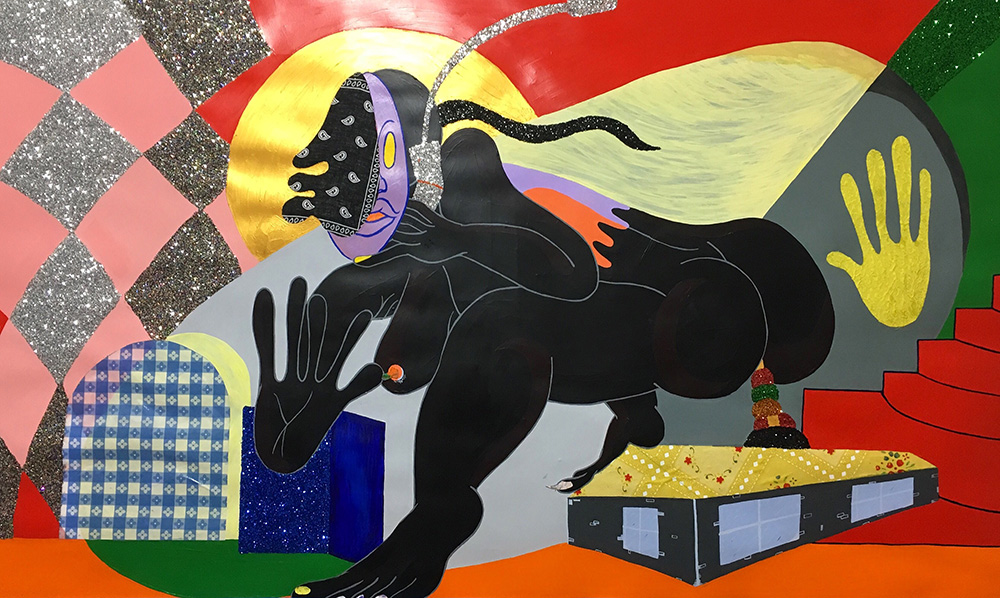
What else about Baltimore comes through in your work?
I’m feeling some kind of way that’s driving me to create something nostalgic that talks about a specific community, but my overall focus is on partnership among women. Body language and other references come from women who grew up in Baltimore City, my mom and my aunt, women on my block. They are just ingrained in me and how I see the idealistic woman. I often make this alternate dimension world, but in my last show, Strange Noise on the Rooftop, there are images of women standing on homes, and some of them are single-family homes, or row homes with a specific brick pattern that I’ve only seen in Baltimore. Certain elements pop up, but I wouldn’t say all my work is about the city, because that would box me in. But I do currently focus on the emotions and the structure of those communities where I grew up.
Are you still doing design and illustration work?
I do quite a bit of freelance work for Vice, and I used to do a lot of posters. I went to undergrad for graphic design, but I didn’t feel like I was being challenged, so I surrounded myself with peers who needed illustrations. Some friends were throwing a really inclusive and diverse music festival called Kahlon, and I was the overall visual person, creating the brand identity. Noisey came down and covered it, and it was something really special that helped me at an early age. This was my introduction to sharing my work, which started as posters or album covers.
It was an interesting way to see reactions through comments online. I’ve been developing my characters since I was 18, but I kept them really private. One had arms but no legs, so she walked on the arms. That’s one I’m working with more and more. I didn’t use her much at first because I didn’t know how she survived.
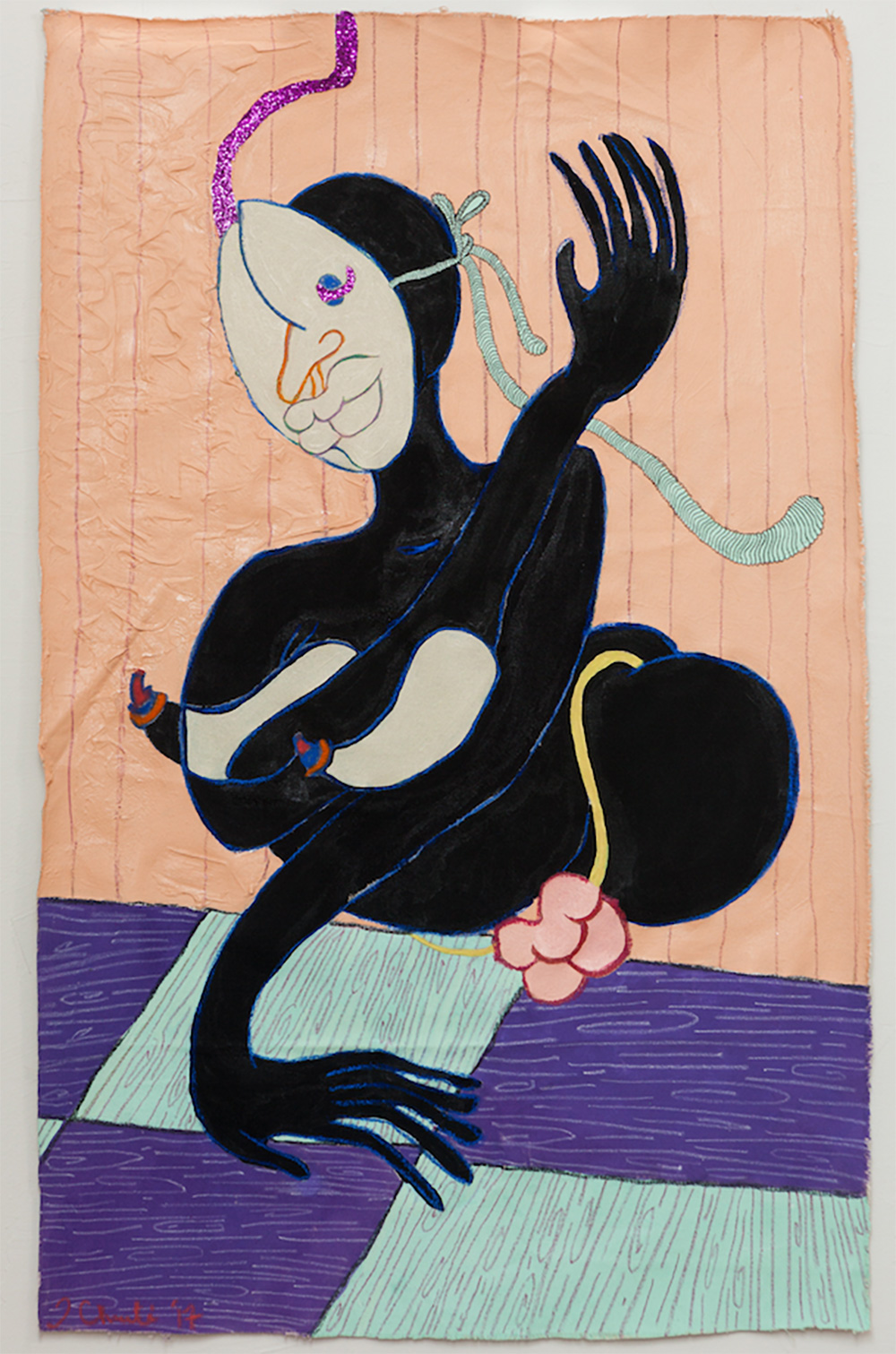
How come she has no legs? She also has six fingers.
Sometimes I do extra fingers. She’s just odd, and to me, that’s enough explanation. I want to continuously show diversity with black women, and maybe you don’t quite understand her, but that’s okay because she’s breathing and she deserves space.
Do many of your characters recur?
I have like a little vault of people that I can reference, and I try to reference myself. I think it’s safest that way. Most of the characters are depicted with masks, and they also have pussy lips, and those are both examples of armor. They represent something you have to put on before you walk outside, referencing how what you see is not the entire person, just a shell of a person, and it’s about that identity. It’s also protection against harm. As a black woman, I feel you need a protective layer just in case, so I often show them doing happy or joyous things, though they’re still wearing these elements. It’s protection against anything that could take your balance away. It’s also a source of pride, the armor, but now I’m showing women without it in really serene places.
Tell me more about how the pussy lips are symbolic.
The foreground of the paintings is the beauty and confidence in the relationships of these black women, despite the negative things that are in proximity to them. I made the pussy lips based on the whole situation that black women have full lips and have been really made fun of and tortured because of that, and to see that exaggerated lips have now become such a phenomenon across races feels really odd. So, the pussy lips in the paintings are armor, but also my innate feature that I wear proudly, and it’s at the center, where your vagina is, so that’s a connection for women, and it’s a really loaded image.
It’s not exactly self-portraiture, but your own image is related to the work.
There are definitely elements that are directly from me. I haven’t figured out if I’m making self-portraits or not. Right now I’m saying no, but there are definitely elements, like scarification and keloids, the hair and the feet. There’s tons of elements, but I think they survive without me, so I don’t know if that still counts as a self-portrait.
I always ask figurative artists what their characters would say out loud.
I create soundscapes because I want to get closer to relating a sound of the environment I’m tapping into. When people view the work, they can hear that and get closer to that reality. Humor is a strong part of my work, and I like to add whimsical qualities. In the soundscapes, I use my own voice, but it’s really distorted.
Tell me more about what you want to communicate about the experience of women.
I want to talk about the beauty of black women because I look at my relationships, and it’s one of the most beautiful things when you have love and support, and you balance one another. I show the relationships with a sense of community I haven’t felt anywhere else besides with women. It’s important to show. Depictions of black women in media throughout history are not often aligned with what I see as important, so I feel it’s my responsibility to create as many positive and realistic images of us as possible. I also want to show how we get hurt, and how we support, how we laugh and get dressed, literally everyday things that I find so special.
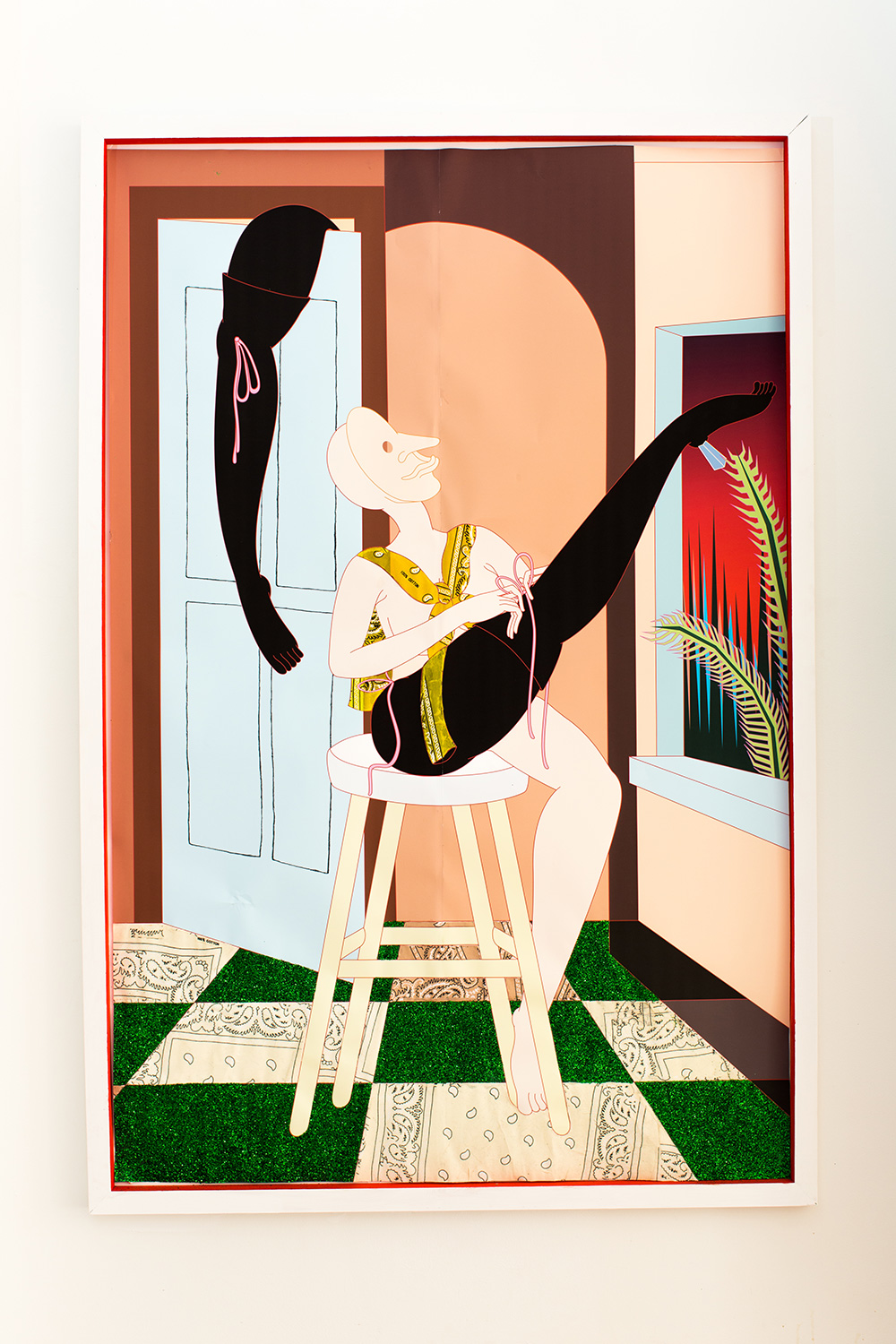
Tell me about your BBW show and if that’s been a theme all along.
That was my first solo, and I was focusing on reclaiming an acronym that is oversexualized in porn—Big Beautiful Women. I thought it was interesting and funny to reintroduce the acronym and focus on black women, but not in an oversexualized way. There is a painting with a woman braiding another woman’s hair, and a piece with a couple where the woman is in front and very grand, and the man is behind her. It’s titled Behind Bae’s Worth, and I wanted to show a woman being confident, but also having a partner who gives the space for her to shine, and he’s not being demanding or controlling.
What does your work say about space and identity, and how they are linked?
The space I’m creating is a positive environment where women can completely be themselves in their entirety. The idea of home as a structure is a metaphor representing ignorance, pain, misunderstanding, misogyny and all these things that can place a woman in a space that she does not want or need to be placed in. So I depicted women on top of houses to show the idea of being close to this structure but also overcoming it.
I was thinking more literally, that it was about people invading your space.
I’ve had experiences that felt like my energy was being sucked out of me for entertainment, just to make other people feel comfortable. I’m not focusing on things like that now, but when I did the BBW show, there was a piece called Beneficial Boot Wearer, and it showed a white woman trying on a boot, but it was literally skin, like a whole leg, and that was an example of trying something on. It’s a whole leg from a person, something from their body that they needed, and this person is just trying it on.
Also, in my Tea Time series, which was a public installation, women were protecting their serene spaces, and everyone was surviving in a teacup or a tea kettle, and I wanted to relate this twisted love of tea. I enjoy tea, and it’s calming, and it became this important thing in my family. My dad’s side is West Indian, and a lot of Caribbeans that were colonized by the British admire things that were left there. Drinking tea is something I wanted to question, so I depicted all the women in teacups feeling great, basically showing us as a community of black people who are often placed in spaces that aren’t our intended spaces, but in order to survive, we make it okay. We do what we can to survive in this space that wasn’t even intended for us. The women are finding ways to be calm, but there is another portion of the piece where one of the figures is carrying a carton of milk, and a few of the angel-like protectors are saying no to mixing their tea with milk. It was more about having black tea. The whole thing was twisted.
My focus is the space being taken, actual objects being taken, and what it looks like when so many things from your community have been taken, and you are still trying to successfully find comfort within a very uncomfortable situation. There’s always someone trying to take, and there are so many forms of taking. I’m interested in nostalgia. If I only made work focusing on being wrong, I’d be doing myself a disservice. Overall, I want people to see that, despite these negative things happening, this woman in this piece is still going.
You said people often ask who’s behind the mask in your paintings.
Right now I’m just showing fractions of who’s behind the mask, and I’m not ready to show the whole face. I have a smaller piece that shows only the legs and feet of a woman standing in front of a mask, which is on the floor, so she’s looking down at it. It’s about looking for this self that you have to put on in order to go out. This woman, while in this safe space, is feeling something when she is faced with putting on this persona. It’s the contemplation right before she bends down to pick it up.
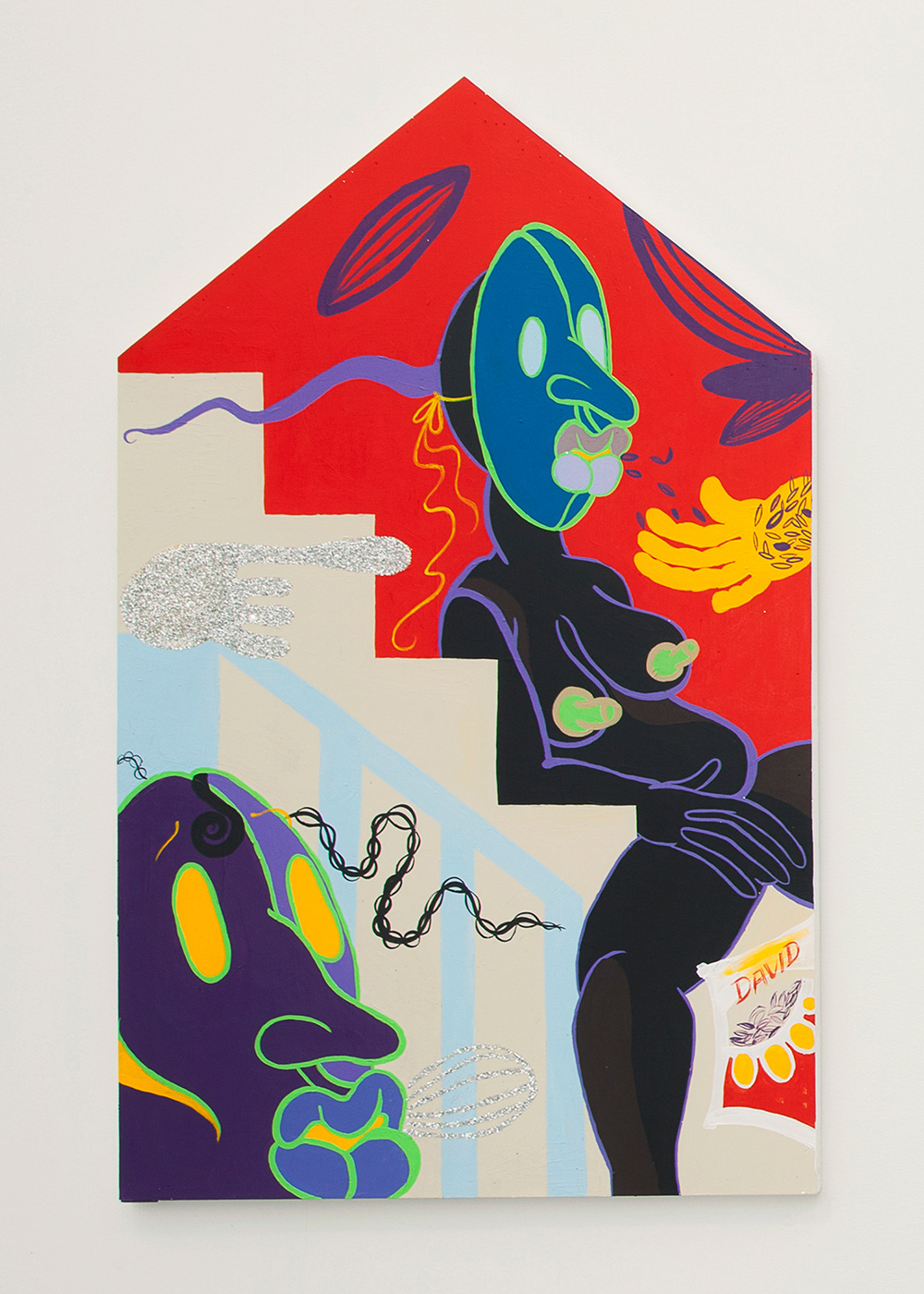
Tell me about the patterns and design elements in the stages you’re setting.
There’s always something happening, and it’s so busy in the environments where I feel most comfortable. My community is constantly innovating, and all of that is inside me when it’s time to pick colors and create movement. I want to get into creating more depth in the work, because I feel like people don’t consider the depth of my community and the history. I’m really excited about pushing that forward for however long I have on this earth to do so.
I’ve put basic insecurities into the pieces, and it’s helped me in the process of seeing them as beautiful. It’s been therapeutic. I have big ol’ feet that are kind of strange, with wide toe gaps, and it’s odd but interesting, so I’ll make figures that look like that, too. The hands have become more stylized and fluid, and it felt natural to mimic that same style in the backgrounds.
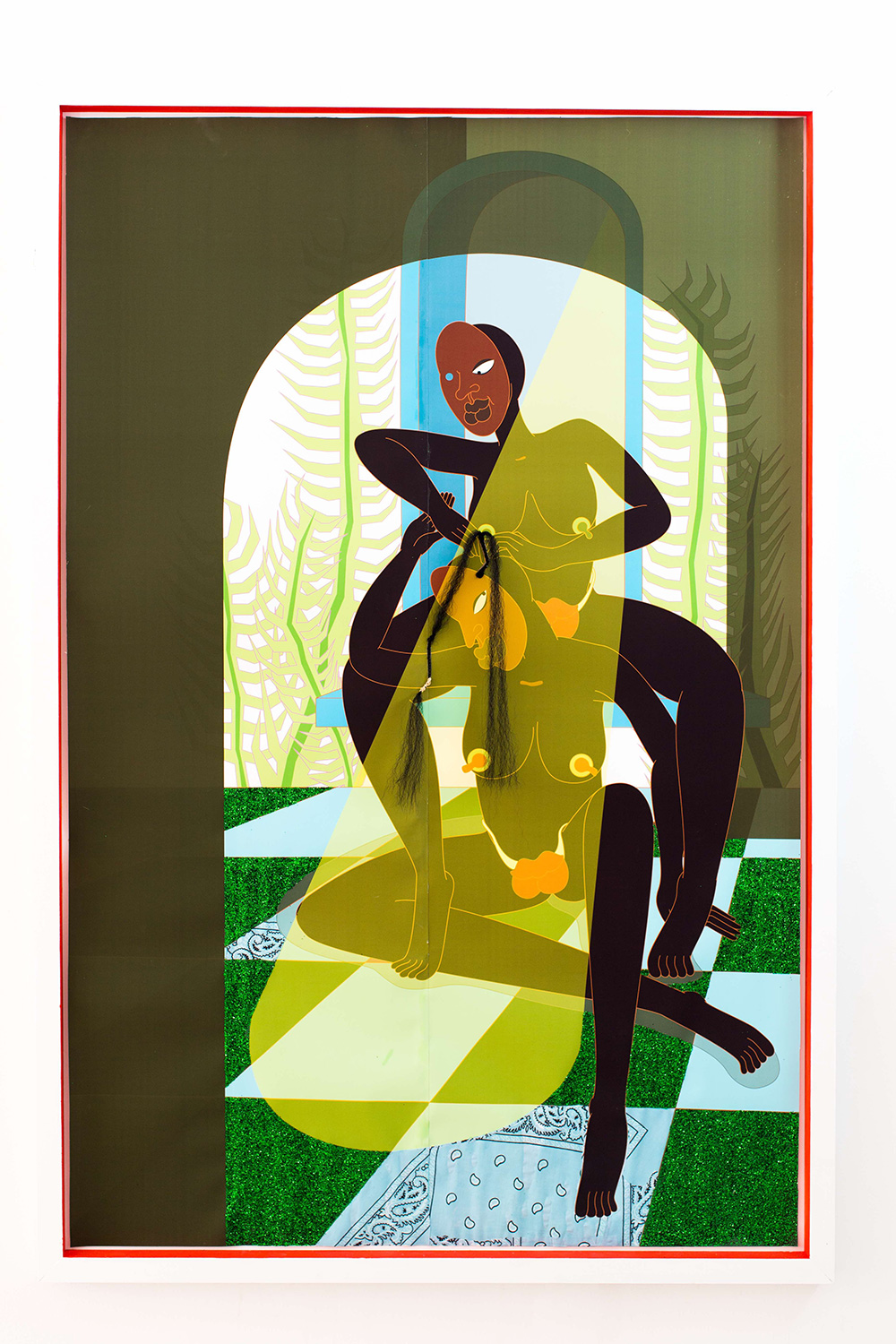
I use keloids on a lot of the figures, which you can’t really see in the photographs. I have a keloid, and it’s hereditary, a scar on my chest. There are certain trigger areas where you can get this type of scar, and people with more melanin are more susceptible to forming them. Your skin heals too quickly in certain areas. My grandmother had one from putting perfume on her chest, which irritated the skin. The same thing happened to my mother, so, growing up, they always told me not to do the perfume thing, and I never did. But I scratched my chest one day, and it didn’t heal properly, and the scar started to grow. I was upset, but at a certain point, I realized I had to find confidence with this scar that’s right at the center of my chest, and I started to find the beauty in it. My mom has it, and my grandmother did, and she’s no longer here, so it feels like this weird connection. I put them in the pieces because there’s no right idea of beauty or perfection. All of these things people would see as imperfections, I’m trying to find confidence within them, and I make the keloids with globs of paint or glitter.
There’s not a lot of research on them and there’s no treatment, because if you mess with it, it could keep growing. A lot of women have it and don’t know what it is. Dermatologists would just want to remove it, but the whole reason you have it is because your skin can’t take trauma, so it just grows back larger. You have to do research about how to holistically treat it. They’re not a focal point of the work, but it’s something that can start a long conversation.
What’s something that feels really important to you, but less important to other people?
I’m really big on storytelling, even for the smallest thing. I want someone to create a seat for me in the space, I want to know where you were and what you ordered, and all this backstory, so I can be immersed in that environment. I think I get that from my grandmother, because she’s from another country, so when I was younger, stories would be super detailed because they were about places I’d never been to or seen. So when people tell me things, I expect that same kind of storytelling, and people do not feel like doing that. If someone says they had a great time, I’m like, “What conversations did you have? What was the vibe? Who performed? What did it look like?” If you had a good time, I want to be placed there. But other people are like, “I just said I had a great time, so that’s it.”
What’s your ideal party?
I often feel like every party I go to falls short because I’m looking for something I’ll never get in this time period. I often wish I could live through other time periods, and mainly for the parties. I want to see something strange, and the DJ has to be constantly playing a diverse range of music. I want lighting, installations, animals... not to be a cliche, but something like Studio 54, clubs in New York from the ’70s and ’80s. I’ve never been to my ideal party, and I always have this vision.
There’s a movie called The Great Beauty, an Italian film from 2013, and within the first few minutes, there’s a party that looks really great, so I guess it’s possible. I’m still searching for that, but I’m not sure it exists in this day and age. I just like spontaneity and random things, and I like to be surprised. I don’t want just one shock factor, but many different ones.
theresachromati.black

